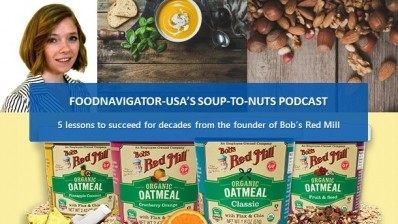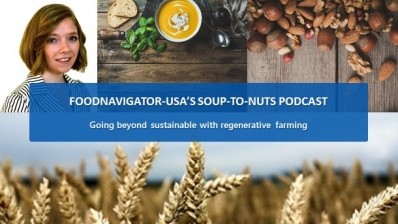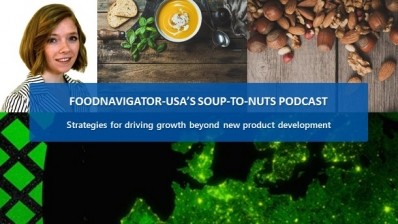Soup-To-Nuts Podcast: How can Blockchain help food & beverage companies, and is it worth the hype?
According to a survey conducted last year by the consultancy Deloitte, more than a quarter of executives in the consumer products, manufacturing, technology and media sectors say incorporating Blockchain technology into their business was a top-five priority in 2017 and that failure to do so soon would place their businesses at a competitive disadvantage.
As such, 42% of executives in the consumer products and manufacturing industry surveyed by Deloitte said they are planning to invest $5 million or more in the coming calendar year, and a quarter of all respondents said they’ve already invested this much or more in blockchcain technology.
But for all their gusto, a staggering two in five senior executives at large US companies surveyed by Deloitte said they had little to no knowledge about blockchain technology and a third said the technology was overhyped.
To help clear up confusion around the technology and better understand its potential for the food and beverage industry, Matt Talbot, CEO of executive management software company GoSpotCheck explains in straight-forward terms what Blockchain is, how it can be used in the food and beverage industries, and who should and shouldn’t use it. In this episode of FoodNavigator-USA’s Soup-To-Nuts podcast he also talks about the technology’s current weaknesses and how artificial intelligence might be a more immediately useful technology in which food and beverage companies should invest.
What is Blockchain and what does it offer food and beverage companies?
Starting with the basics, Talbot explains, “Blockchain is a technology that basically makes it easier to have a secure way to transfer digital assets between parties,” such as crypto-currencies like Bitcoin. It also holds promise as a way to reduce transaction fees, make transactions more secure and ultimately improve the quality of transferring digital assets between parties, he adds.
On the surface, transferring digital assets might not sound very useful for CPG companies that make tangible products. But Talbot explains that Blockchain has near endless potential and some very specific – and much needed – uses for food and beverage companies.
“There will be a massive number of applications for the technology outside of just transferring digital assets,” he said. For example, it could streamline and secure trade promotion settlements between retailers and food and beverage manufacturers, which currently can be cumbersome and costly, Talbot said.
Blockchain also could improve food safety and prevent adulteration or counterfeiting by allowing companies to more easily track goods up and down the supply chain from the farm to the shelf, Talbot said, adding, “the advantage of Blockchain is it really provides an accessible and trustworthy ledger of everything that is moving through the system.”
While this all may sound great, Talbot says realizing the full potential of Blockchain technology for these and other specific uses is still several years away because the applications needed to help companies access Blockchain’s potential haven’t been fully built up yet.
“Blockchain technology is kind of like the Internet. You know, it is not super useful until interesting companies and people begin to build applications and products on top of the core technology … that is very targeted to specific business problems,” Talbot said.
He added that is still 10 to 15 years away. “My gut right now is it is probably pretty similar to where the Internet was in 1995 or so, where there is probably some interesting ideas just beginning to form, but we are still a long way from kind of mass adoptions, mass commercialization and probably even long away from seeing real tangible business impact.”
Artificial intelligence could fill the gap
While big tangible Blockchain-based applications are still years away from fully impacting the food and beverage industry, Talbot says companies currently can use artificial intelligence and machine learning to advance their businesses.
“Artificial intelligence is much closer to being realized, but this has been a big topic in technology for a very long time,” Talbot said.
For example, he says, AI and machine learning can assist food and beverage companies by improving recommendation engines and helping to customize consumers’ shopping experiences based on their purchasing habits and social signals online.
It also can help businesses more effectively work with massive data sets that they have captured over the past few years so that they can better plan and predict what demand will be and what innovations will succeed, he said. This in turn will help develop go-to-market strategies and effective distribution plans with less waste.
Who is best positioned to capitalize on AI?
While there may be a lot of opportunity for artificial intelligence, not every company is primed to fully access it, Talbot warns.
He says larger legacy companies are better positioned to use AI because they generally have more data, a larger operating history, more information about their products, what has worked, what hasn’t and what their customers want. In theory, they also have data management strategies in place.
Startups on the other hand, might struggle to use AI because they haven’t been around long enough to collect the data necessary to feed the machine, Talbot said. He quickly added though that creative startups could still seize the opportunity by sourcing data from third parties.
How much are we talking?
How much investing in Blockchain and artificial intelligence will set companies back depends on their goals and can range into the hundreds of thousands of dollars as indicated by the Deloitte survey, or be relatively inexpensive if a company opts for open-source alternatives.
Talbot also says the cost will depend on with which technology companies food and beverage businesses contract, which is where companies like Talbot’s GoSpotCheck could come into play.
“We are actually very focused on what we call the execution side of the house. So, that means there are certain processes that have to happen day in and day out in order for business to run effectively,” such as auditing, safety checks, sales processes and more, Talbot said.
“All these things we call the execution standards and really critical things that have to be done the right way every time in order to ensure success. So, our software makes it very easy for our customers to set up these processes and then distribute them out to their field workers,” through electronic forms and a dashboard that tracks that status of each “mission,” he explained.
Getting started
When deciding whether blockchain, artificial intelligence or any other technology – or a partner such as GoSpotCheck – is a good fit, Talbot advises companies to start with their goals and then look for technology that will help them achieve them, rather than other way around.
“Half the battle is figuring out your goals and what you are trying to get done, and then the other half is finding the right technologies,” and the right partners who can provide recommendations, education and consultative support, Talbot said.










